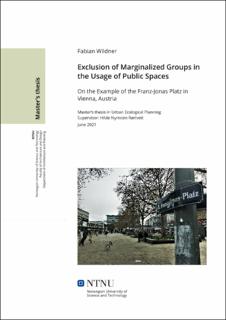| dc.description.abstract | An increasing commercialisation or urban renewal are just a few keywords that jeopardize the inclusiveness in public spaces of today’s neoliberal city. However, the public space has a crucial value for marginalized people, as a space which is freely accessible. Especially the hustle and bustle of public transportation hubs offers people with limited private space or people who do not fit our social norms and are therefore marginalized, a space where they can disappear but also be a part of it and where they do not stand out of the crowd. But the presence of marginalized groups like the homeless or people with substance use disorder in public space does not correspond to the image of a trendy, sanitized ‘most-liveable’ city and therefore municipal authorities are often initiating various ways that should displace these groups.
To elaborate further on this phenomenon, the focus during this research is set on the Franz-Jonas Platz in Vienna, where the introduction of an alcohol ban is being discussed since the last three years. By using a twofold methodology, this thesis will elaborate differences between the ongoing political debate around the alcohol ban’s introduction and the real life-experiences of alleged problems with marginalized people on the Franz-Jonas Platz: A discourse analysis of political protocols hereby reveals the argumentations of the decision-makers and the framing of the alleged problems on the square. Additionally, by means of a social space analysis the actual situation on the site has been investigated. The results of the conducted interviews and observations show a different picture as the one that was transmitted in the politics and the media. Whereas politicians describe the square as being a threat for passers-by, the interviewed people on the square rather stress the square’s qualities and a being together in harmony. The comparison that is made possible with this methodology is exemplifying the conflicts present in urban planning between populist political debates that often dominate against founded, empirical know-how. In this case, the dispute is endangering the livelihoods of marginalized people – the ban is introduced as a very baselessly argued solution that rather displaces problems instead of solving them. The thesis hereby demonstrates how discourses have actual effects in real life. The social space analysis is introduced as a well working tool to examine the people’s needs and opinions that can further help to make a city more inclusive and justice. | |
